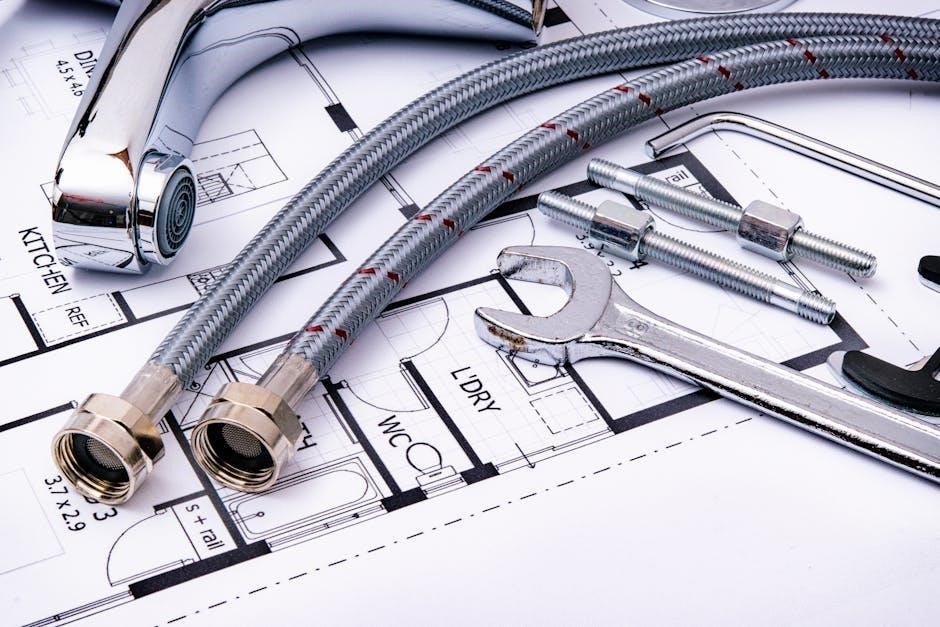A house wiring plan is a detailed blueprint outlining electrical circuits, outlets, and connections, ensuring safety, efficiency, and compliance with local codes for residential installations.
1.1 Importance of a House Wiring Plan
A house wiring plan ensures safety, prevents electrical hazards, and guarantees compliance with local codes. It guides installation, avoids overloaded circuits, and simplifies future modifications. A clear plan also enhances energy efficiency and reduces repair costs. Proper wiring design increases property value and ensures reliable power distribution, making it essential for modern homes.
1.2 Evolution of Wiring Plans in Modern Homes
Modern house wiring plans have evolved to meet increasing electrical demands, integrating smart home technology and energy-efficient systems. Advances in materials and design ensure safer, more reliable connections. Today’s plans prioritize future adaptability, accommodating renewable energy sources and high-speed data networks. This progression reflects the growing need for robust, scalable electrical systems in contemporary living spaces.
Understanding Electrical Systems in Homes
Understanding electrical systems in homes is crucial for ensuring safety and efficiency. It involves knowing how electricity flows through circuits, outlets, and switches, and how to maintain and upgrade them effectively.
2.1 Basics of Residential Electrical Systems
Residential electrical systems involve distributing electricity from the main supply to various parts of a home. Key components include the main breaker box, circuits, outlets, and switches. Understanding voltage, current, and resistance is essential for safe and efficient operation. Safety mechanisms like circuit breakers and grounding protect against overloads and shocks. Proper wiring materials ensure reliable power distribution, making it crucial to follow electrical codes and standards for homeowner safety and system longevity.
2.2 Types of Electrical Wiring Systems
Residential wiring systems are categorized into series, parallel, and radial configurations. Series wiring connects devices in a single path, while parallel allows multiple devices to operate independently. Radial systems, the most common, feature a central power source distributing electricity to various points. Materials like copper and aluminum are used for conductivity. Circuit breakers and grounding enhance safety, ensuring reliable power distribution and protection against faults in modern home electrical setups.

Components of a House Wiring Plan
A house wiring plan includes detailed layouts of circuits, outlets, switches, and panels. It specifies wire gauges, connections, and safety features like grounding to ensure reliable electrical distribution.
3.1 Layout and Design of Wiring Plans
The layout of a wiring plan begins with a clear, organized design. It typically starts by identifying the main electrical panel location, then branches out to individual circuits. Each room’s outlets, switches, and lighting fixtures are mapped precisely. The design ensures safe and efficient power distribution, adhering to local electrical codes. Color coding and symbols are often used for clarity. Proper spacing and labeling enhance readability, making it easier for electricians to follow the plan accurately.
3.2 Key Components Included in Wiring Diagrams
Wiring diagrams include essential components such as the main electrical panel, branch circuits, outlets, switches, and lighting fixtures. Symbols represent wires, connectors, and devices. Color coding distinguishes live, neutral, and ground wires. Detailed labels indicate amperage ratings and circuit numbers. Grounding systems are highlighted for safety. These elements ensure clear communication of the electrical system’s structure and functionality, aiding installers and inspectors in understanding the wiring layout accurately.

Steps to Create a House Wiring Plan
Creating a house wiring plan involves assessing electrical needs, designing circuits, selecting materials, and ensuring compliance with safety codes for efficient and safe installation.
4.1 Assessing Electrical Needs and Requirements
Assessing electrical needs involves identifying power requirements, load calculations, and future upgrades. Evaluate appliance usage, circuit breaker capacity, and safety standards to ensure efficient and reliable electrical system design for your home.
4.2 Drawing a Detailed Wiring Diagram
Drawing a detailed wiring diagram involves creating a clear visual representation of your home’s electrical system. Use specialized tools or software to map out circuits, outlets, switches, and connections. Ensure accuracy by labeling components and indicating voltage levels. This diagram serves as a guide for electricians and helps ensure compliance with safety codes and regulations during installation and future upgrades.

Safety Considerations in House Wiring
Safety in house wiring is critical to prevent accidents. Always follow electrical codes, use proper materials, and be aware of potential hazards to ensure secure installations.
5.1 Safety Precautions for DIY Wiring
DIY wiring requires strict safety measures to avoid risks. Always turn off power, use insulated tools, and follow circuit diagrams. Ensure proper grounding and never work on live circuits. Keep flammable materials away and avoid overloaded circuits. It’s crucial to adhere to local electrical codes and consider consulting a professional if unsure. Safety should never be compromised for convenience.
5.2 Common Electrical Hazards and Solutions
Common electrical hazards include overloaded circuits, faulty wiring, and improper grounding. Solutions involve installing circuit breakers, using high-quality materials, and ensuring proper insulation. Regular inspections and adherence to safety standards can mitigate risks. Addressing these issues promptly prevents fires and ensures system reliability. Always prioritize professional assistance for complex problems to maintain safety and efficiency in home wiring systems.
Permits and Inspections for House Wiring
Obtaining necessary permits ensures compliance with local electrical codes, while inspections verify safety and proper installation, preventing potential hazards and legal issues down the line.
6.1 Importance of Electrical Permits
Electrical permits are crucial for ensuring safety and compliance with local codes. They verify that wiring meets legal standards, preventing hazards and potential legal issues. Permits are legally required before starting work, and inspections confirm proper installation. Failure to obtain them can result in fines or system shutdowns. They protect homeowners from unsafe electrical conditions and ensure that certified professionals have approved the work.
6.2 Inspection Process for Wiring Installations
The inspection process ensures wiring installations meet safety standards and local codes. Certified inspectors verify connections, circuits, and components. They check for proper grounding, wire sizing, and compliance with regulations. If issues are found, corrections must be made before approval. Regular inspections prevent hazards and ensure reliable electrical systems. They provide peace of mind for homeowners and are essential for maintaining a safe living environment.

Tools and Materials Needed for Wiring
Essential tools include wire strippers, pliers, screwdrivers, and multimeters. Key materials are insulated wires, circuit breakers, outlets, and switches, ensuring safe and efficient electrical connections.
7.1 Essential Tools for Electrical Wiring
Essential tools for electrical wiring include wire strippers, pliers, screwdrivers, and multimeters. These tools ensure accurate wire stripping, secure connections, and safe voltage testing. Additionally, a wire cutter and crimping tool are necessary for preparing and connecting wires. A drill with bits helps install outlets and switches. Proper tools are crucial for efficient and safe wiring installations, preventing errors and hazards.
7.2 Recommended Materials for Safe Wiring
Recommended materials for safe wiring include high-quality copper or aluminum wires, PVC-insulated cables, and flame-retardant connectors. Circuit breakers and surge protectors are essential for overload protection. Grounding wires ensure safety by redirecting fault currents. Proper insulation and durable materials prevent electrical fires and shocks. Using certified, heat-resistant components guarantees compliance with safety standards and ensures long-term reliability in residential wiring systems.

Troubleshooting Common Wiring Issues
Troubleshooting involves identifying faults like short circuits or open connections, often resolved by checking wire integrity, connections, and circuit breakers to restore electrical functionality safely and efficiently.
8.1 Identifying Faults in Wiring Systems
Identifying faults in wiring systems involves checking for signs like flickering lights, tripped breakers, or unusual odors. Use multimeters to test voltage and continuity, ensuring connections are secure. Inspect wires for damage or wear, and verify circuit overloads. DIYers should disconnect power before troubleshooting to avoid risks. Professional assistance is recommended for complex issues to ensure safety and compliance with electrical standards, preventing further damage or hazards;
8.2 Solutions for Common Electrical Problems
Common electrical issues like flickering lights or tripped breakers can often be resolved by checking connections or replacing faulty components. Resetting circuit breakers or replacing blown fuses may restore power. For outlet problems, ensure proper wiring and test with another device. If issues persist, consulting a licensed electrician is advisable to prevent hazards and ensure compliance with safety standards, avoiding further complications or potential risks.

Best Practices for House Wiring
Always use high-quality materials, follow local electrical codes, and ensure proper insulation. Regular inspections and maintaining clear wiring diagrams enhance safety and efficiency in electrical systems.
9.1 Following Electrical Codes and Standards
Adhering to local and national electrical codes ensures safety and compliance. These standards dictate wiring methods, circuit requirements, and safety measures. Compliance prevents hazards and legal issues, ensuring reliable electrical systems. Always consult updated codes for current regulations.
9.2 Ensuring Energy Efficiency in Wiring
Energy efficiency in wiring minimizes power consumption and reduces costs. Key strategies include using high-efficiency cables, installing smart panels, and optimizing circuit layouts. LED lighting and automated controls further enhance energy savings. Proper insulation and voltage regulation also play crucial roles in maintaining efficiency; Regular audits and upgrades ensure systems remain energy-effective over time.
Future-Proofing Your House Wiring
Future-proofing involves designing wiring systems to adapt to emerging technologies and increased power demands, ensuring scalability and compatibility with smart home devices and energy-efficient solutions.
10.1 Upgradability of Electrical Systems
Upgradability ensures electrical systems can evolve with technological advancements. Scalable designs allow for easy additions of circuits or devices without major overhauls. High-capacity cables and modular panels facilitate future upgrades, accommodating smart home technologies and increased power demands. Flexible wiring layouts enable seamless integration of new appliances and energy-efficient solutions, ensuring long-term functionality and adaptability for changing household needs and innovations in electrical engineering.
10.2 Preparing for Smart Home Technology
Preparing for smart home technology involves installing a robust network infrastructure and compatible wiring. A centralized control system and high-speed data cables ensure seamless connectivity. Smart devices require dedicated circuits for stable power supply. Future-proof wiring plans include provisions for IoT integration, voice assistants, and automated systems. Adequate surge protection and energy-efficient wiring layouts are essential to support advanced smart home features and ensure reliable performance, adapting to evolving technological demands and innovations.
A well-designed house wiring plan ensures safety, efficiency, and future readiness. Proper planning and adherence to standards are crucial for reliable electrical systems and smart technology integration.
11.1 Summary of Key Points
A house wiring plan is essential for safety, efficiency, and future readiness. It provides a roadmap for installations, avoiding hazards and ensuring code compliance. Proper planning enables smart technology integration and energy efficiency. Quality materials and tools ensure reliability, while best practices and permits guarantee a secure electrical system. Adherence to standards and continuous maintenance are vital for long-term functionality and adaptability in modern homes.
11.2 Final Thoughts on House Wiring Plans
A well-planned house wiring system is crucial for safety, efficiency, and future readiness. It ensures reliable power distribution and supports smart technology integration. Regular updates and adherence to electrical codes are essential for maintaining safety and functionality. Investing in a quality wiring plan now prevents costly issues later, offering long-term benefits and peace of mind for homeowners.